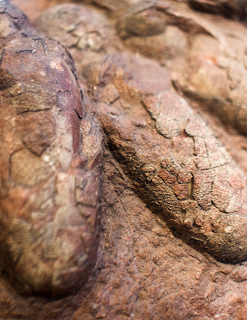 |
| A delightful red crested hadrosaur |
Parasaurolophus was one of the last of the duckbills to roam the Earth and their great crests were the original trumpets.
We now know that their bizarre head adornments help them produce a low B-Flat or Bb. This is the same B-Flat you hear wind ensembles tune to with the help of their tuba, horn or clarinet players.
You can image these crested dinosaurs signaling the morning reveille, joy or sounding the alarm over great distances with their bugle-like calls to the other plant-eating members of their herd.
These herbivorous ornithopod dinosaurs lived in what is now North America — and possibly Asia — during the Late Cretaceous, about 76.5–73 million years ago.
Parasaurolophus had an interesting jaw structure with dental batteries containing hundreds of teeth that allowed these plant-eaters to tackle their meals with a sort of grinding motion analogous to chewing.
With all that grinding came significant wear and tear on their specialized dentition so they evolved to have extra teeth waiting in reserve. They dined on plants from the ground up to a height of 4 metres or 13 feet. Once chosen, they would bite their chosen vegetarian meal, begin grinding and any extra green, leafy bits were held in their jaws by a cheek-like organ.
 |
| Hadrosaur Eggs |
Parasaurolophus was a hadrosaurid, part of a diverse family of Cretaceous dinosaurs known for their range of bizarre head adornments. This genus is known for its large, elaborate cranial crest, which at its largest forms a long curved tube projecting upwards and back from the skull.
Charonosaurus from China, which may have been its closest relative, had a similar skull and potentially a similar crest. Visual recognition of both species and sex, acoustic resonance, and thermoregulation has been proposed as functional explanations for the crest beyond its trumpeting roar.
It may have produced low-frequency noises, similar to elephants, that you and I wouldn't hear but help them keep in touch over vast distances. The infrasounds of elephants are between 1 to 20 Hertz and can be heard by the herd up to 10 kilometres away.
Enter Charles H. Sternberg in New Mexico
 |
| Charles H. Sternberg, American Palaeontologist |
Sternberg was an American fossil collector and palaeontologist active in the field from 1876 to 1928. He collected fossils for a whose who of famous folk and museums including Edward Drinker Cope and Othniel C. Marsh, and for the British Museum, the San Diego Natural History Museum and other museums.
He sent his specimen to Uppsala, Sweden, where Carl Wiman described it as a second species, P. tubicen, in 1931. The specific epithet is derived from the Latin tǔbǐcěn or trumpeter.
A second, nearly complete P. tubicen skull (NMMNH P-25100) was found in New Mexico in 1995. Using computed tomography scanning of the skull, Robert Sullivan and Thomas Williamson gave the genus a thorough analysis and interpretation of its anatomy and taxonomy, including various hypothesis for the functions of its crest. Williamson later published an independent review of the remains challenging the previous taxonomic placement.
John Ostrom described another good specimen (FMNH P27393) from New Mexico as P. cyrtocristatus in 1961. Ostrom was an American palaeontologist who revolutionized our understanding of dinosaurs in the 1960s.
His find from New Mexico included a partial skull with a short, rounded crest, and much of the postcranial skeleton except for the feet, neck, and parts of the tail. Its specific name was derived from the Latin curtus "shortened" and cristatus "crested." The specimen was reported as being found at the top of the Fruitland Formation but was likely from the base of the overlying Kirtland Formation.
The range of this species was expanded in 1979, when David B. Weishampel and James A. Jensen described a partial skull with a similar crest (BYU 2467) from the Campanian-age Kaiparowits Formation of Garfield County, Utah. Since then, another skull has been found in Utah with the short/round P. cyrtocristatus crest morphology.
References:
- Abel, Othenio (1924). "Die neuen Dinosaurierfunde in der Oberkreide Canadas". Jarbuch Naturwissenschaften (in German). 12 (36): 709–716. Bibcode:1924NW.....12..709A. doi:10.1007/BF01504818.
- Bakker, R.T. (1986). The Dinosaur Heresies: New Theories Unlocking the Mysteries of Dinosaurs and their Extinction. William Morrow. p. 194. ISBN 978-0-8217-2859-8.
- Benson, R.J.; Brussatte, S.J.; Anderson; Hone, D.; Parsons, K.; Xu, X.; Milner, D.; Naish, D. (2012). Prehistoric Life. Dorling Kindersley. p. 342. ISBN 978-0-7566-9910-9.
- Brett-Surman, Michael K.; Wagner, Jonathan R. (2006). "Appendicular anatomy in Campanian and Maastrichtian North American hadrosaurids". In Carpenter, Kenneth (ed.). Horns and Beaks: Ceratopsian and Ornithopod Dinosaurs. Bloomington and Indianapolis: Indiana University Press. pp. 135–169. ISBN 978-0-253-34817-3.
- Carr, T.D.; Williamson, T.E. (2010). "Bistahieversor sealeyi, gen. et sp. nov., a new tyrannosauroid from New Mexico and the origin of deep snouts in Tyrannosauroidea". Journal of Vertebrate Paleontology. 30 (1): 1–16. doi:10.1080/02724630903413032.
